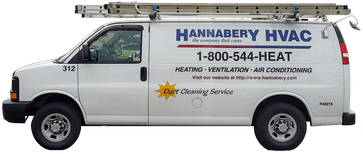Commonly Reported HVAC Problems:
Copyright © 1997 Hannabery HVAC. All rights reserved.
Heat pump iced-up in Winter:

Heat pumps can ice-up during the winter time. And it is normal for the entire coil to be covered in a white frost, even light ice, during certain weather conditions. But it is not normal for the entire unit to be encased in ice; including the top of the unit and the insides of the coil for an extended period of time. This indicates a problem and should be addressed quickly to save energy and avoid serious damage to the equipment.

Heat pumps will naturally ice-up in the winter but will periodically go into a defrost cycle to de-ice the coils. This keeps the unit running efficiently. If the coils are blocked by ice, proper heat transfer between the refrigerant and the outside air cannot occur. The unit pictured left, was iced-up so badly, it damaged the fan blades, crushed the outdoor coils; causing the refrigerant to leak out and ruined the compressor - a complete loss.
How does the defrost cycle work?

On a call for defrost, the reversing valve is energized, switching the system into the air conditioning mode. That is right - Air Conditioning. The outdoor evaporator becomes the condenser but at the same time the outdoor fan shuts off. This allows the high pressure refrigerant circulating through the outdoor coil to get very warm, melting the ice.
At the same, the second stage heat (the back-up heat) is energized to offset or temper the cold air now blowing out the vents. When a sensor or thermostat in the outdoor unit reaches a certain temperature and/or a certain amount of time goes by, the system goes back to normal heating mode. At this time a cloud of water vapor can usually be seen rising out of the outdoor unit and a "whoosh" sound can be heard as the refrigerant reverses direction. The entire process usually takes between 2 to 10 minutes depending on conditions.

Different heat pumps have different ways of determining when to go into defrost. Some (older models) use mechanical timers in conjunction with a defrost thermostat. If the thermostat is cold enough and enough time goes by, the unit will go into the defrost mode, whether it's iced-up or not. When the thermostat heats up to a certain temperature, defrost is terminated. Hopefully at this time, much of the frost has melted off.
Most of the newer equipment today uses solid-state control modules with temperature sensors. Even more sophisticated is the Demand Defrost system which makes calculations based on the outside air, the refrigerant temperature in the coil, and run time. This is the most efficient way to defrost.
If a heat pump is severely iced-up during winter use, it's possible that it's not defrosting, but there are many other causes.
Below is a list of possible causes. Items in red usually require a service call. The bottom four causes in blue are commonly found problems and can be addressed, even fixed by the homeowner.
- Bad defrost control or timer
- Bad defrost thermostat or sensor
- Bad defrost relay
- Sticking reversing valve
- Bad reversing valve solenoid coil
- Bad outdoor fan motor
- Low refrigerant charge
- Restriction
- Outdoor coil blocked - possibly with leaves or snow drift
- Unit sunk in ground - nowhere for ice to melt and drain off
- Leaking gutter dripping water onto top of unit
- Freezing rain - causes top of unit to freeze over - once this happens the rest of the unit will also freeze over
A few more things to consider...
- If the top of the heat pump is covered in ice, turn it off and remove the ice.
- If a gutter is dripping on the heat pump, repair the gutter.
- Keep snow and leaves away from the heat pump including underneath it.
- If the heat pump has settled into the ground, it must be elevated - usually on blocks or special feet. (Should be done by a technician)
- With the outdoor unit off, (you can set your thermostat to emergency heat), ice can be removed with a garden hose. If the heat pump ices-up again, it is time to schedule a service call.
Important: Whatever you do, please, never pick the ice off with a sharp object. The refrigerant coils and fins can be damaged very easily.
Please keep in mind that the information found on our website is provided free of charge and Hannabery HVAC does not assume any liability resulting from the information we provide. We hope this information helps, but please note that these are just rough guidelines, and not all possible situations are covered. Your HVAC system should be inspected and repaired by a trained technician.
How Comfortable Do You Want To Be?
How Comfortable Do You Want To Be?
[Must be in our service area]

